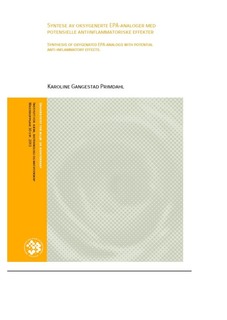| dc.description.abstract | Synteser av de tre oksygenerte EPA-forbindelsene (6E,8Z,11Z,14Z,17Z)-5-hydroksy-6,8,11,14,17-eikosapentaensyre (5-HEPE, 16), (6E,8Z,11Z,14Z,17Z)-metyl-5-hydroks-6,8,11,14,17-eikosapentaenoat (31) og (6E,8Z,11Z,14Z,17Z)-metyl-5-okso-6,8,11,14,17-eikosapentaenoat (36) har blitt gjennomført.
Det ble ikke tid til å syntetisere enantiomerene av hverken 16 eller 31.
Det ble utarbeidet en HPLC metode med en kiral kolonne som ga grunnlinjeseparasjon av enatiomerene av 31.
Det ble i tillegg gjort forsøk på å analysere enantiomerene av 31 ved å derivatisere forbindelse 31 både med R- og med S-Mosher-syreklorid. Separasjon av de diastereomere forbindelsene 37 og 38 ved HPLC med en akiral kolonne ble forsøkt uten hell. Derivatiseringen av 31, basert på NMR spektra av forbindelse 37 og 38, viste seg å være vellykket.
De siste årene har flere studier av ulike okysgenerte PUFA metabolitter vist en rekke interessante biologiske aktiviteter. De biologiske egenskapene til forbindelsene 16, 19 og 31 skal testes i et Ca2+ immobiliserings assay.24 Dette vil gi indikasjoner på disse forbindelsenes anti-inflammatoriske egenskaper in vitro. Syntheses of three oxygenated EPA compounds (6E,8Z,11Z,14Z,17Z)-5-hydroxy-6,8,11,14,17-eicosapentaenoic acid (5-HEPE, 16), (6E,8Z,11Z,14Z,17Z)-methyl-5-hydroxy-6,8,11,14,17-eicosapentaenoate (31) and (6E,8Z,11Z,14Z,17Z)-methyl-5-oxo-6,8,11,14,17-eicosapentaenoate has been successfully accomplished. There was not enough time to complete the synthesis of the last compound, 5-oxo-ETE (19), but since the other EPA metabolites were obtained, the probability is high that the synthesis of 5-oxo-ETE should be achieved, as well. The plan was also to prepare the enantiomers of both 16 and 31, but the time was insufficient.
A HPLC method developed with a chiral column gave base line separation of the enantiomers of 31.
In addition to this it was also made an attempt to analyze the enantiomers of 31 after reaction with both the R- and S-Mosher acid chloride. The diastereomers 37 and 38 was attempted separated by the use of an HPLC equipped with an achiral column. NMR spectra of both 37 and 38 indicated that the desired compounds were obtained. Unfortunately, no separation of these two diastereomers was achieved by HPLC within the timelines of this project.
During the last few years studies of different oxygenated PUFA metabolites has shown a number of interesting biological activities. The biological properties of compounds 16, 31 and 36 will be tested in a Ca2+ immobilizing assay.24 This will provide an indication of the compounds anti-inflammatory properties in vitro. | no_NO |
